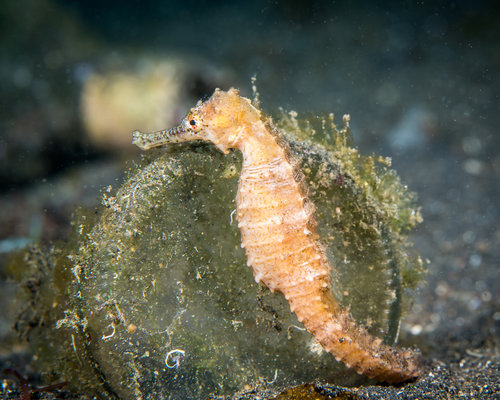A spotless three-spot seahorse!

Hippocampus trimaculatus, the three-spot seahorse. Photo by DavidR/iSeahorse
Our celebrity species this month is Hippocampus trimaculatus, aka the three-spot seahorse. Thanks, iSeahorse user davidr, for spotting this spotless three-spot!
Project Seahorse biologist Lily Stanton had a tricky time identifying this fish, as, like Oddball from the classic animated movie "102 Dalmatians", this specimen lacks the spots adorning their kin. What gave away its identity was the backwards-facing hooked spine jutting out of its chin, an even more distinctive H. trimaculatus trait than the 3 spots typically found along their back.
Trimaculatus translates to three-spot, and many fish have this word as the latter half of their binomial name. This includes the three-spot wrasse (Halichoeres trimaculatus), three-spot angelfish (Apolemichthys trimaculatus), three-spot grouper (Epinephelus trimaculatus), three-spot grunter (Hephaestus trimaculatus), and three-spot barb (Enteromius trimaculatus), among others. There’s also a three-spot dung beetle (Scybalocanthon trimaculatus)! While these other three-spotted species are listed as Least Concern by the IUCN Red List, the three-spot seahorse has the unfortunate distinction of being the only Vulnerable trimaculatus thus far.
Perhaps this three-spot’s threatened status is because, unlike Oddball, who was able to outrun Cruella before the glamourous villain was trapped in a giant cake and subsequently arrested, the largely sedentary seahorse is unable to escape danger. Since H. trimaculatus happens to hang out in the exact sort of habitat favoured by tropical shrimp - sandy, muddy substrates - this seahorse is particularly prone to becoming shrimp trawler bycatch.
Not much is known about their exact numbers, so we really appreciate when iSeahorse users like davidr (and you!) contribute to our knowledge base with pics like this.
To learn more about these species, check out the IUCN Red List website: https://www.iucnredlist.org/species/10087/17252219
View the original observations here: https://www.iseahorse.org/Observations/Details/20623732





Comments
Add a Comment